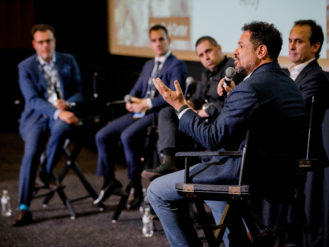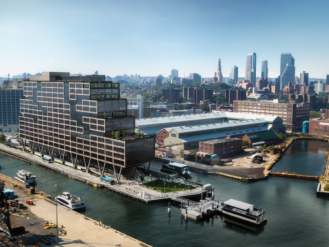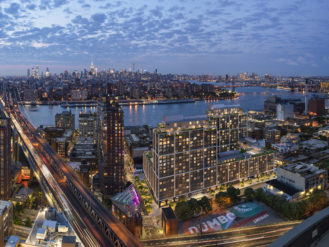Meet the Blogger Who Got the Paul Manafort Scoop
Katia Kelly of 'Pardon Me for Asking' covered her Brooklyn neighborhood with a hyper-local focus. Then she got a hot tip and ran with it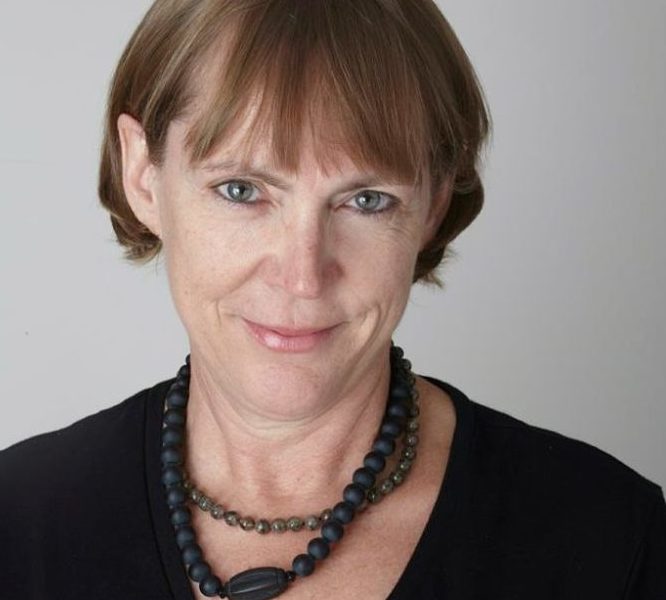
Katia Kelly, whose blog Pardon Me for Asking covers Carroll Gardens and the surrounding area (Photo by Max Kelly)
Katia Kelly had spent a decade writing her blog about Carroll Gardens, puckishly titled Pardon Me for Asking, till her fame recently shot far beyond the neighborhood. She had made waves locally over the years, going after pushy developers and profligate school administrators. She was a champion of the Gowanus Canal cleanup. She celebrated the arrival of new restaurants and mourned the passing of shops that failed. Last year she uncovered an apparent house of ill repute in the neighborhood. Then she came upon a story in February that still reverberates on a national scale.
One day Kelly was walking around the neighborhood taking photos to post to her blog when a woman struck up a conversation and asked if Kelly wanted “a scoop.” Of course, said Kelly. When the woman asked Kelly if she knew who owned a house on the block, Kelly assumed it would be yet another show-business celebrity. “When she told me ‘Paul Manafort,’ I was a bit stunned. I confirmed that she was talking about the Paul Manafort,” Donald Trump’s former campaign advisor and controversial friend of Russia. Kelly immediately walked over to the address, 377 Union St., to check out the house and take photos.
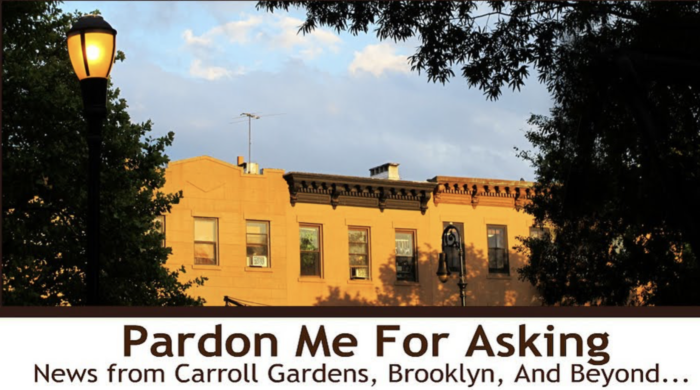
Kelly started her blog in 2006, around the time the neighborhood started changing dramatically (Image courtesy of Pardon Me for Asking)
“I knew almost instantly that this was a big story,” says Kelly. But it was not simply the fact that Manafort owned the house. “That was just mildly interesting to me at first. It was the fact that the neighbors had looked into its ownership because the house had been empty for over three years. The front door had been replaced with a piece of plywood. A huge chain and padlock secured the place. Cinderblock and rusted I-beams had been stored in the front yard for the past year and a half. The place looked abandoned.”
The neighbors, weary of the eyesore, had done some research on their own. They found that the brownstone was owned by a limited liability corporation (LLC), which might have been difficult to trace except that a building permit filed with the city in 2013 mentions a name associated with the corporation: Paul Manafort. Adding to the intrigue, the mortgage on the building looked quite large.
Following up with her own research, Kelly found a tangle of puzzling transactions. “The fact that he had paid cash for the building in 2013, but had taken out several large mortgages, which exceeded the value of the house in February 2017, interested me the most,” said Kelly. “That raised some red flags, especially because there had just been news reports that he had received $12 million from the former Ukrainian administration. With so much money, why take on debt? It also seemed strange that banks would hand over almost $7 million for a house that is probably only worth $3.5 million in its current state.”
Going With the Story
When Kelly had gathered enough information, she took a deep breath and went ahead with her story, headlined “Washington Lobbyist and Trump Advisor Paul Manafort Owns Brownstone In Carroll Gardens.” The media responded, first the real-estate blog Brownstoner and then the New York Post. Two lawyers did their own research and created a pop-up blog, 377Union. A reporter from WNYC met with Kelly while exploring the pattern of Manafort’s other holdings in the city. Even the New Yorker took notice, interviewing Kelly about how she got that story. The mainstream media, which sometimes fail to give neighborhood bloggers credit for their scoops, were respecting this one.
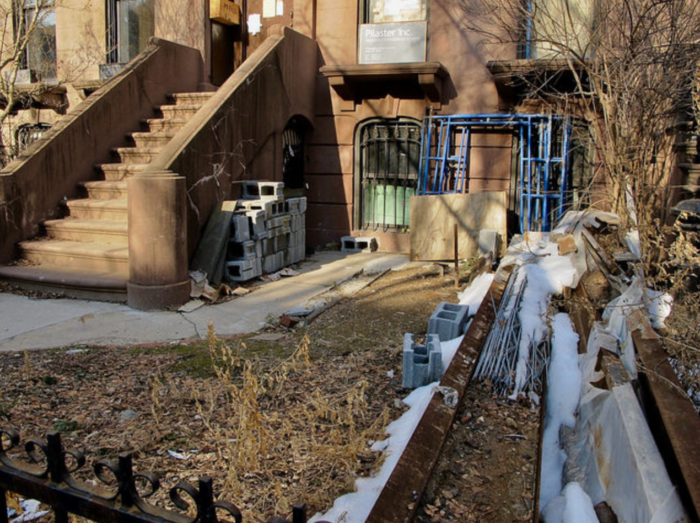
The messy front yard at Paul Manafort’s house that drew the attention of neighbors (Photo by Katia Kelly)
As the Manafort story grew, prompting speculation about money laundering and global intrigue, Kelly realized it had moved beyond the block. “I was relieved that the story was now in the hands of professionals who had the means to investigate further.” But she did follow up on the local angle when workers went to the Manafort house to clean up the unsightly mess. And then again about people who used to live in the house. “I find it incredibly ironic that the story came to light because Manafort was a bad neighbor and had failed to take care of his property.”
A Decade on the Beat
While this was Kelly’s first national scoop, faithful readers of PMFA have come to expect a regular journalistic bouquet of garden photos and incisive questions, all inspired by affection for her adopted neighborhood. She arrived three decades ago, a European who felt at home among the brownstone blocks of Carroll Gardens.
Kelly was born in Germany to German parents. Her father worked for a French company, who transferred him to France when Kelly was ten years old. They spent five years in the Auvergne, a mountainous region in central France (she returns every summer). Then her father was transferred again, this time to Long Island, where she had to learn her third language and hated the suburbs. Kelly fled to the city, studied at Parsons School of Design, and went into the fashion industry. After she married her husband, a Brooklyn native who owns an office-furniture company, they bought a brownstone to fix up and started a family.
In their first two decades in Carroll Gardens, as their son and daughter made their way through public schools, “the neighborhood hardly changed at all,” Kelly says. “Occasionally, an older neighbor would pass away, a brownstone would be sold and renovated, a store would close, but mostly, things stayed pretty much the same, year after year.” She started a blog, at first as a way of keeping up with her European friends. But she quickly realized that the story was all around her. “About ten years ago, as Brooklyn became the new ‘chic’ borough, Carroll Gardens was targeted by developers and the impact on the neighborhood was drastic,” she recalls. “House prices skyrocketed, rents tripled, and in the case of commercial rents, quadrupled. Mom-and-pop stores began closing. Local residents who had spent most of their lives here felt as though they were no longer welcome.”
Gadfly of the Developers
“I began documenting these changes as a way to hold on to some of the past. I started attending community meetings and realized that they were not well attended since most of them were scheduled during the day, when people were at work. The issues were not often covered by mainstream media, so I began sharing my impressions and posting videos of the meetings on PMFA,” Kelly said.
She turned into a journalist, one with a point of view. “I also spoke out at meetings, urging developers to make their buildings more contextual and to be more respectful of the neighborhood. I have been called a ‘NIMBY’ often, but I always make the argument that developers have a responsibility to a community,” said Kelly. “It drives me crazy when a developer presents his out-of-scale, non-contextual luxury condo and claims he was inspired by the ‘fabric of the surrounding brownstone neighborhood.’ That seems like a slap in the face, especially when the new building bears no resemblance to its surroundings.”

A bouquet at East One Coffee Roasters, a shop opening recently covered by Pardon Me for Asking (Photo by Katia Kelly)
She exposed many garish blueprints, help lead a campaign to improve Carroll Park, and as a member of the PTA, put heat on a deficit-spending school administrator. But the crusade in which she takes the most pride is her support for cleaning up the toxic Gowanus Canal, just three blocks from her house. “In 2008, the city of New York was getting ready to rezone most of the area around the canal from manufacturing to residential,” she recalls. “Roughly at that time, the Environmental Protection Agency proposed placing the canal on its Superfund list. There was a lot of pushback from the city because Mayor Bloomberg and our then-councilman Bill de Blasio reasoned that the area would be stigmatized by the designation and that real-estate developers would abandon their plans of building luxury housing there. I felt that the clean-up needed to happen first.” Together with neighborhood activists, Kelly worked with the EPA, visited elected officials, and kept local residents informed. The EPA declared the Gowanus Canal a Superfund site in 2010 and Kelly has been a member of the EPA’s community-advisory group from its beginning.
The Kelly children are now grown. Her daughter works for the Lower East Side Tenement Museum. “She tells people that growing up with an immigrant mother in a 150-year-old brownstone in Brooklyn makes her appreciate the history of New York’s old buildings and the stories that they can teach us.” Her son is a photographer of food, travel and lifestyles, who recently moved to Austin. She clings to hope he’ll return to Brooklyn.
For all her recent impact on the news, Kelly is an increasingly rare bird. Neighborhood bloggers have become less common partly because of the rise of social media like Twitter and Facebook, but also because Google ads don’t financially support blogs the way they used to. While Kelly runs a few ads to pay expenses, she never expected the blog to make her rich. “If I turned PMFA into a business, it would lose its authenticity and my credibility as a neighborhood blogger. Pardon Me For Asking is really my gift back to a neighborhood I fell in love with over 30 years ago.”





